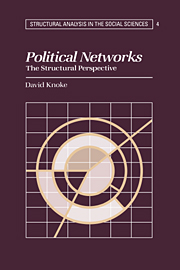Book contents
- Frontmatter
- Contents
- List of tables and figures
- Preface
- Acknowledgments
- 1 Politics in structural perspective
- 2 Voting and political participation
- 3 Social movements (written with Nancy Wisely)
- 4 Organizational power (written with Naomi J. Kaufman)
- 5 Community power structures
- 6 Elites in the nation state
- 7 International relations (written with Jodi Burmeister-May)
- 8 Toward a structural political economy
- Appendix: Some fundamentals of network analysis
- References
- Index
5 - Community power structures
Published online by Cambridge University Press: 02 October 2009
- Frontmatter
- Contents
- List of tables and figures
- Preface
- Acknowledgments
- 1 Politics in structural perspective
- 2 Voting and political participation
- 3 Social movements (written with Nancy Wisely)
- 4 Organizational power (written with Naomi J. Kaufman)
- 5 Community power structures
- 6 Elites in the nation state
- 7 International relations (written with Jodi Burmeister-May)
- 8 Toward a structural political economy
- Appendix: Some fundamentals of network analysis
- References
- Index
Summary
During the past half century, research on community power structures increasingly embraced the structural perspective. The earliest case studies of small towns and cities tried to find people and groups that wielded disproportionate power over public decisions. Who controlled spending on schools, sewers, parks, sports arenas, and other public works? Who decided zoning regulations, pollution controls, and urban renewal programs? What determined private investments in homes, businesses, new plants, and employment? Several studies revealed wealthy local business elites at the core of leadership cliques that dominated municipal politics to the exclusion of the larger populace. Pluralists challenged this monolithic image, arguing that power was broadly dispersed among many competing political groups that resolved controversies by negotiation, accommodation, and compromise. Unfortunately, the initial structural insights were soon obscured by a sterile debate over reputational and decisional methodologies alleged to produce foregone conclusions about power distributions. By 1970, political scientists had largely abandoned community power research (Ricci, 1980: 462; but see Bulmer [1985] who argues that neighborhood research is being revived with a network emphasis).
The early structural analyses of community power were further eclipsed by a diffusion of multivariate methods from status attainment research to the ecological analysis of urban phenomena. Using data on entire cities as units of analysis, researchers tried to explain taxing, spending, and municipal policies as linear functions of such variables as formal government, urban populations, growth rate, racial composition, poverty, city age, and absentee-owned corporations.
- Type
- Chapter
- Information
- Political NetworksThe Structural Perspective, pp. 119 - 148Publisher: Cambridge University PressPrint publication year: 1990
- 1
- Cited by

